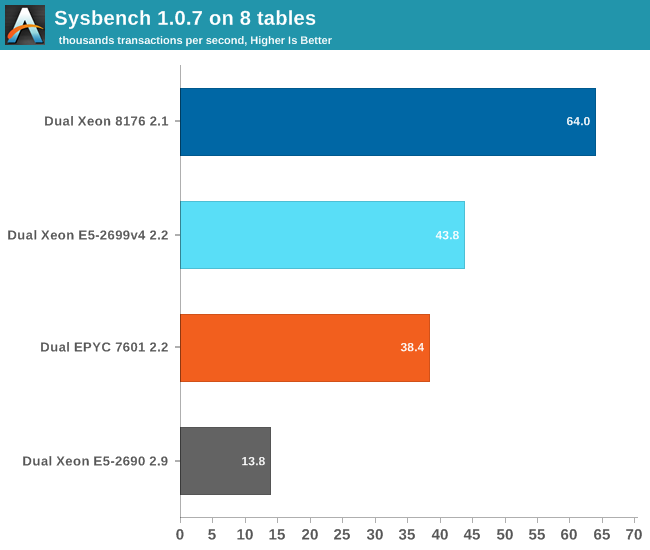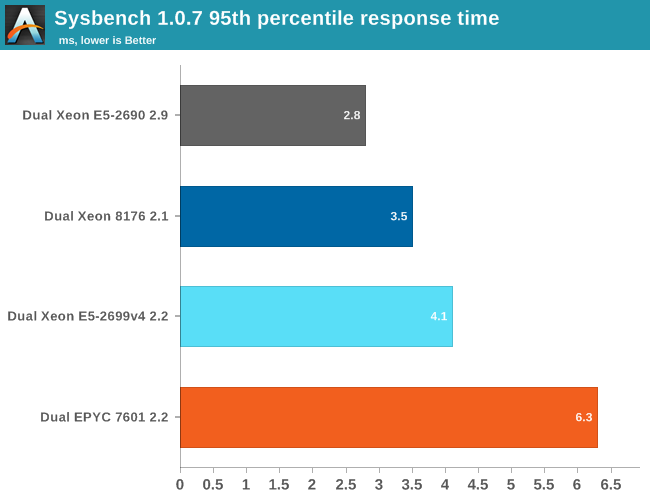Sizing Up Servers: Intel's Skylake-SP Xeon versus AMD's EPYC 7000 - The Server CPU Battle of the Decade?
by Johan De Gelas & Ian Cutress on July 11, 2017 12:15 PM EST- Posted in
- CPUs
- AMD
- Intel
- Xeon
- Enterprise
- Skylake
- Zen
- Naples
- Skylake-SP
- EPYC
Database Performance: MySQL Percona Server 5.7.0
For database benchmarking we still base our testing on Percona server 5.7, an enhanced drop-in replacement for MySQL. But we have updated our SQL benchmarking once again. This time we use Sysbench 1.0.7, which is a lot more efficient than the previous 0.4 and 0.5 versions. As a result, the measured numbers are quite a bit higher, especially on the strongest systems. So you cannot compare this with any similar Sysbench-based benchmarking we have done before.
For our testing we used the read-only OLTP benchmark, which is slightly less realistic, but still much more interesting than most other Sysbench tests. This allows us to measure CPU performance without creating an I/O bottleneck.

As expected, the EPYC 7601 can not deliver high database performance out of the box. A small database that can be mostly cached in the L3-cache is the worst case scenario for EPYC. That said, there are quite a few tuning opportunities on EPYC. According to AMD, if you enable Memory Interleaving, performance should rise a bit (+10-15%?). Unfortunately, a few days before our deadline our connection to the BMC failed, so we could not try it out. In a later article, we will go deeper into specific tuning for both platforms and test additional database systems.
Nevertheless, our point stands: out of the box is the EPYC CPU a rather mediocre transactional database CPU. With good tuning it is possible EPYC may pass the Xeon v4, but the 8176 is by far the champion here. It will be interesting to measure how EPYC compares in the non-transactional databases (Document stores, Key-value...) but transactional databases will remain Intel territory for now.

Typically when high response times were reported, this indicated low single threaded performance. However for EPYC this is not the case. We tested with a database that is quite a bit larger than the 8 MB L3-cache, and the high response time is probably a result of the L3-cache latency.










219 Comments
View All Comments
CajunArson - Tuesday, July 11, 2017 - link
Would a high-end server that was built in 2014 necessarily update? Maybe not.Should a high-end server with a brand new microarchitecture use the most recent version of the software if it has any expectation of seeing a real benefit? Absolutely.
If this was a GPU review and Anandtech used 2 year old drivers on a new GPU (assuming they even worked at all) we wouldn't even be having this conversation.
BrokenCrayons - Tuesday, July 11, 2017 - link
Home users playing video games are in a different environment than you find in a business datacenter. There's a lot less money to be lost when a driver update causes a performance regression or eliminates a feature. Conversely, needlessly updating software in the aforementioned datacenter can result in the loss of many millions if something goes wrong.wallysb01 - Tuesday, July 11, 2017 - link
Conversely, having stuff working, but unnecessarily slowly costs money as well. Its a balance, and if you're spending hundreds of thousands or even millions on a cluster/data center/what have you, you'd probably want to spend at least a little bit of time optimizing it, right?Icehawk - Tuesday, July 11, 2017 - link
Most of the businesses I have worked for, ranging from 10 people to 50k, use severely outdated software and the barest minimum of patching. Optimization? HA!For example I work for a manufacturer & retailer currently, our POS system was last patched in 2012 by the vendor and has been replaced by at least two versions newer. We have XP machines in each of our stores as that is the only OS that can run the software.
The above is very typical. The 50k company I worked for had software so old and deeply entrenched that modernizing it is virtually impossible. My current company is working on getting to a new product... that was new in 2012 and has also been replaced with a newer version. Whee!
Icehawk - Tuesday, July 11, 2017 - link
One other thing - maybe the big shops actually do test/size but none of the places I have worked at and have been involved in do any testing, benchmarking, etc. They just buy whatever their preferred vendor gives them that meets the budget and they *think* will work. My coworker is in charge (lol) of selecting servers for a new office... he has no clue what anything in this article is. He has never read a single review, overview, or test of a processor. I could keep going on like this :(0ldman79 - Wednesday, July 12, 2017 - link
Icehawk's comments are so accurate it is scary.I can't tell you how many businesses running custom *nix software running in a VM on a Windows server.
They're not all about speed. Reliability is the single most important factor, speed is somewhere down the line. The people that make those decisions and the people that drink coffee while they're waiting on the machines are very different.
Neither understand that it could all be done so much better and almost all of them are utterly terrified at the concept of speeding up the process if it means *any* changes are made.
JohanAnandtech - Friday, July 21, 2017 - link
We did test with NAMD 2.12 (Dec 2016).sutamatamasu - Tuesday, July 11, 2017 - link
Glad, AMD make back again to this segment, now we can only see what can Raja to do for server market with Radeon instinct.Kaotika - Tuesday, July 11, 2017 - link
So this confirms that the previous information regarding Skylake-X core configurations was wrong, and 12-core variant is in fact using HCC-core instead of LCC-core?Ian Cutress - Tuesday, July 11, 2017 - link
We corrected that in our Skylake-X review.